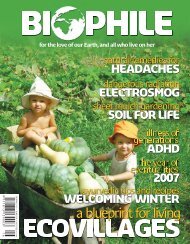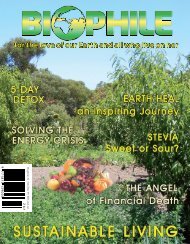B io ph ile Issu e 18 - Biophile Magazine
B io ph ile Issu e 18 - Biophile Magazine
B io ph ile Issu e 18 - Biophile Magazine
Create successful ePaper yourself
Turn your PDF publications into a flip-book with our unique Google optimized e-Paper software.
food from treesPerhaps one of the best known wildfruits of Africa come from thehighly valued Marula (Maroela) tree– Sclerocarya birrea - which growsin the bushveld and woodlands fromKwa-Zulu Natal through Swaziland,Botswana, the northern parts of SouthAfrica, Mozambique and Zimbabwe.The fruits are fairly large sweet-smelling,greenish-yellow berries containing a large, veryhard seed. Inside each seed there are three nuts.In late summer the berries ripen and fall to theground where the strong scent attracts aplethora of wildlife. Reports of intoxicatedele<strong>ph</strong>ants and baboons are not uncommonas over-ripe fruits ferment, giving offstrong, turpentine-like smells.The Marula tree belongs to the samefamily (Anacardiaceae) as the mango,pistach<strong>io</strong> and cashew nuts, and also thepepper tree ( Schinus molle) which is socommon in the Karoo where it offers wearytravellers some respite from the heat at laybysalong the Great North Road.Marulas are deciduous trees; they cannottolerate frost, seldom grow to over 9m and have spreading crowns with dense,graceful foli-age. The delicate,spiky flow-ers are eithermaleor female(oc-cas<strong>io</strong>nally abi-sexual flowerisproduced) andareusually carriedonseparate trees.Only rarely do the maleflowers produce a fruit.Insects flock to theflowering trees in summer,their loud hummingcan be heard somedistance away, giving onethe feeling of noisy heat.As a food plant, the Marulais outstanding. The fleshy fruitis tart, thirst -quenching and energyboosting;it’s very rich in Vitamin C evenwhen fermented. By the way, the juice isalso claimed to be an a<strong>ph</strong>rodisiac!The nuts, incredibly difficult to extractfrom their shells, have a very high energyvalue, and contain roughly 30% protein and60% fat; an excellent source of nutrients.They are used by people in many ways,some examples are included in the recipesect<strong>io</strong>n that follows.And now, if you live in the right part ofthe world and you’re lucky enough to haveone of these trees in your backyard, hereare a few recipes for you to try:Marula Jelly2 kg ripe Marula berriesSugar (heated in oven)• Halve the berries, press the pips outinto a mixing bowl and squeeze the berriesThe wonderfulMarula treeThere is little wonder that the Marulatree is held in such high regard as everypart of it is used in one way or another.Quite apart from its value as a food tohumans, insects and game animals:▶▶The bark contains an anti-histaminewhich soothes the blisters caused byhairy caterpillars.▶▶The timber is fairly light and soft andis used for furniture, panelling, drums,divining bowls and dishes.▶▶It is used as a pro<strong>ph</strong>ylactic, to cure malaria,and eye disorders, and also in thepractice of magic, right down to the useof the bark from a male or female treeto pre-determine the sex of the unbornchild..▶▶The Zulus and Tongas call it ‘the marriagetree’; it is important in fertility rites,and for instilling a baby girl with softfeminine traits.▶▶The dense crown provides shelter,shade and food for wild animals, andreduces the evaporat<strong>io</strong>n of water fromholes in the tree trunk.▶▶The magnificent green lunar mothlays her eggs on the leaves; the caterpillarhatches out, eats and then pupates inlarge cocoons which are used tradit<strong>io</strong>nally,filled with small pebbles, as anklerattles.▶▶Marula oil is used in face creams andother body products, including the Enchantrixrange.▶▶The oil is reputed to be a good preservative,and when drizzled onto fresh meatwhich is then dried and stored, it keepsfor up to a year.▶▶The tree has huge potential as a cultivated,multi-purpose crop.Soil for Liferuns monthly workshops in CapeTown on all aspects of organicgardening. Check our website (www.soilforlife.co.za) for details of theseworkshops. Book early to avoiddisappointment!hard over a mixing bowl to extract juice.• Cover the pips and juice with water andturn out into a saucepan (not aluminium).• Boil for 15 minutes.• Strain through a nylon sieve linedwith damp muslin.• Use 250 ml heated sugar to 250 mlstock.• Heat at a low temperature and stiruntil sugar has melted.• Increase temperature and boil for20 minutes, or until setting point isreached. You can test for this by doing the‘wrinkle test’. Put a blob of the hot juice onto theback of an ice cube tray. Push with yourfinger. If the blob wrinkles, it is ready.• Spoon hot jelly into sterilised jars withscrew tops and seal.This jelly is best served with a rich venisonpie or stew.Marula juice5 kg ripe MarulasSugar• Pierce the berries so that the juice canescape and place in a saucepan, cover withwater and simmer for 20 minutes.• Strain through a muslin cloth. Don't stir.• Add 7 cups of sugar for every 10 cups ofextract . Add lemon juice to taste.• Bottle whilst still hot, in sterilised hotbottles.• Date the bottles and store in a cool, darkplace. Serve with ice in summer.And then there are some interestingtradit<strong>io</strong>nal African recipes (gleaned fromthe ‘The Evaluat<strong>io</strong>n of the Marula Projectin Bushbuckridge in Limpopo Province’,prepared by Felicia Chiloane and JacksonPhala)XiguguPut biltong (dried meat) and kernelsin a mortar. Stamp until it is well mixed.Remove the mixture and place it in a bowl.Pour a spoon of marula oil over the mixture.It is now ready to be served.LekomaBraai maize meal until it is brownish incolour. Put maize meal into a mortar, addkernels and a bit of salt and sugar. Thenstamp all the ingredients until well mixed.Serve.Last, but not least, you could alwaysbrew your own beer!References:Medicinal Plants of South Africa – Ben-Erik van Wyk, Boschvan Oudtshoorn, Nigel Gericke. Brize Publicat<strong>io</strong>ns 1997Field Guide to Trees of Southern Africa – Braam van Wyk andPiet van Wyk. Struik Publishers (Pty) Ltd 1997Trees of Southern Africa, Volumes 23 – Eve Palmer andNorah Pitman. A A Balkema/Cape Town 1972People’s Plants. A guide to useful plants of S. Africa – Ben-Erik van Wyk, Nigel Gericke. Briza Publicat<strong>io</strong>ns 2000Everyone’s Guide to Trees of South Africa – Keith, Paul andMeg Coates-Palgrave. CNA 1985Food Plants of the World- Ben-Erik van Wyk. Briza Publicat<strong>io</strong>ns2005Southern African Trees – a Photogra<strong>ph</strong>ic guide – Piet vanWyk. Struik Publishers 1993The Last Hours of Ancient Sunlight – Thom Hartman, ThreeRivers Press, 1998South African Game Cookbook - Rina Pont, Human & Rousseau(Cape Town, Johannesburg)Chef Justin Patterson of Chef-on-Call, www.chefoncall.co.zaB<strong>io</strong><strong>ph</strong><strong>ile</strong> <strong>Issu</strong>e <strong>18</strong>57

















